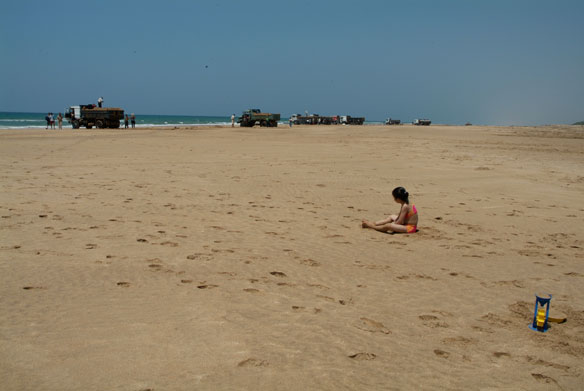
Beach sand mining. Photograph courtesy of: Lana Wong for © SAF — Coastal Care.
“Sand is the second most consumed natural resource, after water. The construction-building industry is by far the largest consumer of this finite resource. The traditional building of one average-sized house requires 200 tons of sand; a hospital requires 3,000 tons of sand; each kilometer of highway built requires 30,000 tons of sand… A nuclear plant, a staggering 12 million tons of sand…” Captions by “Sand Wars” Award-Winning Filmmaker: Denis Delestrac (© 2013).
Excerpts;
How big industries’ use of sand has compromised the health of California’s beaches and what recent action against the CEMEX plant means for the Monterey Bay…
Read Full Article, Santa Cruz Waves (06-23-2016)
How to Steal a Beach, Atlas Obscura (07-18-2016)
In Northern California’s Monterey Bay, a peculiar thing happens every time there’s a storm. The California Coastal Commission says that a mining operation has been illegally taking precious sand for years…
Cemex mine reflects human hunger for sand, California; Monterey County Now(01-14-2016)
The disappearance of the beach reflects an alarming reality: Southern Monterey Bay, Marina in particular, has the highest coastal erosion rate in the state of California. For more than 20 years, scientists have speculated about the sand mine’s contribution to that erosion rate, and a 2008 study concluded it was the primary cause. The Cemex mine in Marina is the only remaining coastal sand mine in the entire United States. Which leads to new questions…
Monterey Bay, California: Beach Sand Mining from a National Marine Sanctuary; By Gary Griggs (09-01-2014)
The 30-mile long, continuous sandy shoreline around Monterey Bay is the most visited stretch of shoreline on the central coast. Yet, it holds the dubious distinction of being the only active beach sand mining operation along the entire United States shoreline. To make matters even worse, it all takes place along the shoreline of a protected National Marine Sanctuary. Something is seriously wrong with this picture…
Why Sand Is Disappearing ; By John R. Gillis; The New York Times (12-04-2014)
To those of us who visit beaches only in summer, they seem as permanent a part of our natural heritage as the Rocky Mountains and the Great Lakes. But shore dwellers know differently. Beaches are the most transitory of landscapes, and sand beaches the most vulnerable of all…
Sand Thieves Are Eroding World’s Beaches For Castles Of Cash, by Martine Valo, Le Monde (09-2013)
The pillaging of sand is a growing practice in the world. This is because it represents 80% of the composition of concrete that it is the object of such greed…
Sand, Rarer Than One Thinks: A UNEP report (GEA-March 2014)
Despite the colossal quantities of sand and gravel being used, our increasing dependence on them and the significant impact that their extraction has on the environment, this issue has been mostly ignored by policy makers and remains largely unknown by the general public.
In March 2014 The United Nations released its first Report about sand mining. “Sand Wars” film documentary by Denis Delestrac – first broadcasted on the european Arte Channel, May 28th, 2013, where it became the highest rated documentary for 2013 – expressly inspired the United Nations Environment Programme (UNEP) to publish this 2014-Global Environmental Alert.
Sand Wars, An Investigation Documentary, By Mutlti-Awards Winner Filmmaker Denis Delestrac








